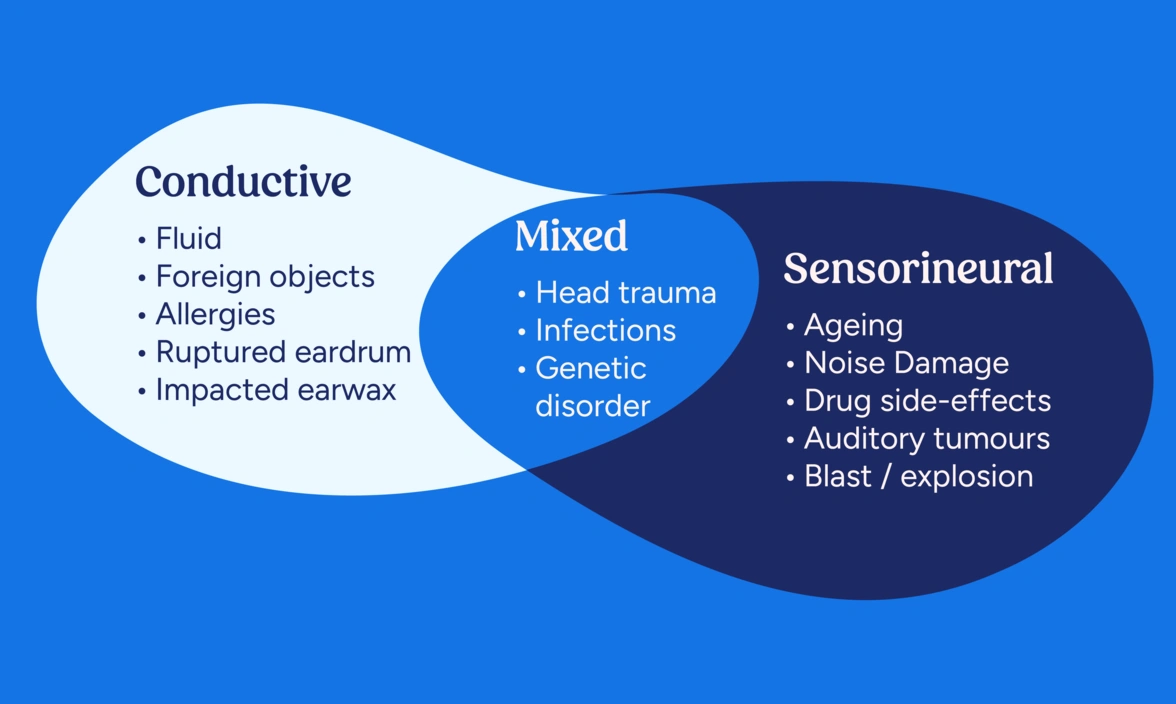Types of hearing loss
There are two main types of hearing loss – conductive hearing loss and sensorineural hearing loss. Mixed hearing loss occurs when these two types combine.
There are two main types of hearing loss – conductive hearing loss and sensorineural hearing loss. Mixed hearing loss occurs when these two types combine.

Conductive hearing loss occurs when a condition or problem in the outer or middle ear prevents sound waves from reaching the cochlea (inner ear).
Common reasons for this type of hearing loss include:
Conductive hearing loss is a common type which affects children, but adults can also suffer from it too. Those impacted will find hearing soft sounds difficult, and louder sounds will appear muffled.
It can happen suddenly, or a person may notice a steady decline in their hearing.
Symptoms associated with conductive hearing loss include sounds becoming quieter or muffled, pain or tenderness in the ear, and dizziness or ear feeling full.
Sudden Sensorineural hearing loss (SSHL) is a sudden drop in hearing within three days (72 hours or less). It is also commonly known as sudden hearing loss.
Symptoms include immediate loss of hearing, vertigo (dizziness), tinnitus, balance issues, nausea and a full sensation in the ear.
It can be caused by a variety of disorders that affect the inner ear or central hearing system and occur for the following reasons, including:
Sudden hearing loss is usually not medically or surgically treatable and is generally permanent.
If the symptoms (a sudden drop in hearing) are recognised early, it is important to seek urgent medical care from a hospital A&E and ask to see an ENT specialist.
This video requires marketing cookies to be viewed. Please accept cookies to view this video content.
An audiogram (a hearing test) is required to diagnose SSHL. It will assess the degree and severity of the hearing loss. However if arriving at the Accident and Emergency department (A&E) out of normal working hours, the audiology department may not be open.
If this is the case, it is worth considering obtaining an audiogram from a private audiology practice to take with you. They can also visually assess your ear to check for earwax or infection.
If there is not access to a private or NHS audiologist, then the A&E doctor should take advice from an ENT specialist as a matter of urgency and discuss whether steroid treatment should be started as a precaution.
Steroid treatment within 24-48 hours of onset is said to significantly improve your chance of the hearing returning and acting quickly is crucial. A hearing test should be arranged as soon as possible.
Detailed information and blog specialising in the topic of sudden hearing loss – what it is, how it is diagnosed and the treatments available.
When there is both a conductive and sensorineural hearing loss, it is called mixed hearing loss.
Symptoms of this type of hearing loss, include:
A mixed hearing loss can be caused due to several factors which include genetic disorders, infection or head trauma.
It is important to have any sudden changes in hearing checked by a medical professional.
Registered charity in England and Wales no. 293358 and in Scotland no. SC040486. Royal Patron HRH The Princess Royal.